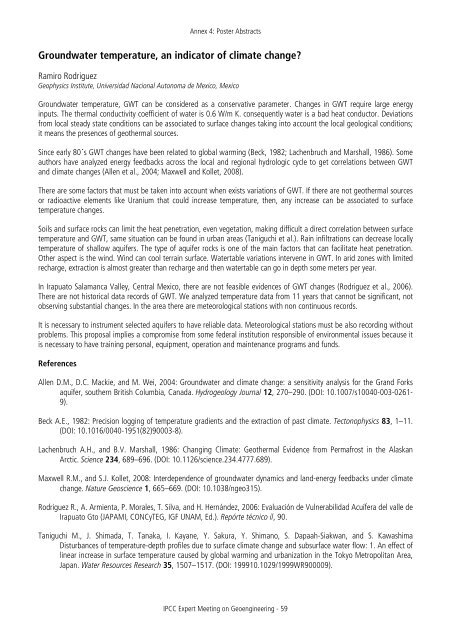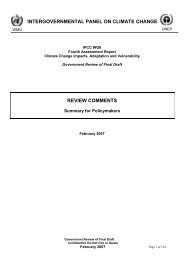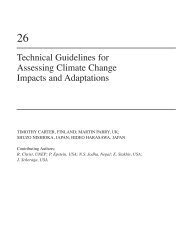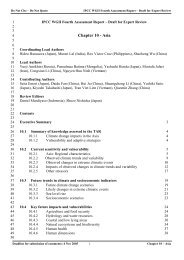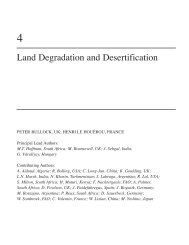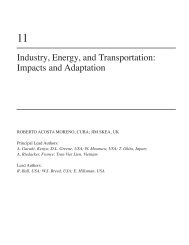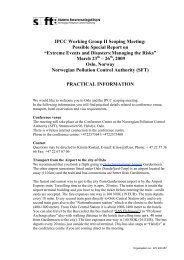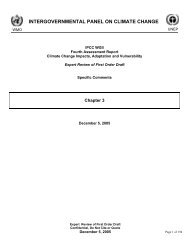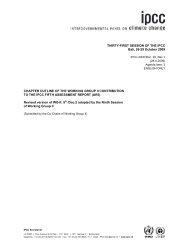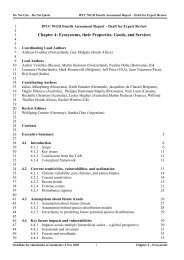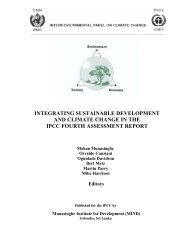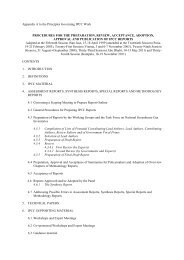IPCC Expert Meeting on Geoengineering
IPCC Expert Meeting on Geoengineering
IPCC Expert Meeting on Geoengineering
Create successful ePaper yourself
Turn your PDF publications into a flip-book with our unique Google optimized e-Paper software.
Annex 4: Poster Abstracts<br />
Groundwater temperature, an indicator of climate change?<br />
Ramiro Rodriguez<br />
Geophysics Institute, Universidad Naci<strong>on</strong>al Aut<strong>on</strong>oma de Mexico, Mexico<br />
Groundwater temperature, GWT can be c<strong>on</strong>sidered as a c<strong>on</strong>servative parameter. Changes in GWT require large energy<br />
inputs. The thermal c<strong>on</strong>ductivity coefficient of water is 0.6 W/m K. c<strong>on</strong>sequently water is a bad heat c<strong>on</strong>ductor. Deviati<strong>on</strong>s<br />
from local steady state c<strong>on</strong>diti<strong>on</strong>s can be associated to surface changes taking into account the local geological c<strong>on</strong>diti<strong>on</strong>s;<br />
it means the presences of geothermal sources.<br />
Since early 80´s GWT changes have been related to global warming (Beck, 1982; Lachenbruch and Marshall, 1986). Some<br />
authors have analyzed energy feedbacks across the local and regi<strong>on</strong>al hydrologic cycle to get correlati<strong>on</strong>s between GWT<br />
and climate changes (Allen et al., 2004; Maxwell and Kollet, 2008).<br />
There are some factors that must be taken into account when exists variati<strong>on</strong>s of GWT. If there are not geothermal sources<br />
or radioactive elements like Uranium that could increase temperature, then, any increase can be associated to surface<br />
temperature changes.<br />
Soils and surface rocks can limit the heat penetrati<strong>on</strong>, even vegetati<strong>on</strong>, making difficult a direct correlati<strong>on</strong> between surface<br />
temperature and GWT, same situati<strong>on</strong> can be found in urban areas (Taniguchi et al.). Rain infiltrati<strong>on</strong>s can decrease locally<br />
temperature of shallow aquifers. The type of aquifer rocks is <strong>on</strong>e of the main factors that can facilitate heat penetrati<strong>on</strong>.<br />
Other aspect is the wind. Wind can cool terrain surface. Watertable variati<strong>on</strong>s intervene in GWT. In arid z<strong>on</strong>es with limited<br />
recharge, extracti<strong>on</strong> is almost greater than recharge and then watertable can go in depth some meters per year.<br />
In Irapuato Salamanca Valley, Central Mexico, there are not feasible evidences of GWT changes (Rodriguez et al., 2006).<br />
There are not historical data records of GWT. We analyzed temperature data from 11 years that cannot be significant, not<br />
observing substantial changes. In the area there are meteorological stati<strong>on</strong>s with n<strong>on</strong> c<strong>on</strong>tinuous records.<br />
It is necessary to instrument selected aquifers to have reliable data. Meteorological stati<strong>on</strong>s must be also recording without<br />
problems. This proposal implies a compromise from some federal instituti<strong>on</strong> resp<strong>on</strong>sible of envir<strong>on</strong>mental issues because it<br />
is necessary to have training pers<strong>on</strong>al, equipment, operati<strong>on</strong> and maintenance programs and funds.<br />
References<br />
Allen D.M., D.C. Mackie, and M. Wei, 2004: Groundwater and climate change: a sensitivity analysis for the Grand Forks<br />
aquifer, southern British Columbia, Canada. Hydrogeology Journal 12, 270–290. (DOI: 10.1007/s10040-003-0261-<br />
9).<br />
Beck A.E., 1982: Precisi<strong>on</strong> logging of temperature gradients and the extracti<strong>on</strong> of past climate. Tect<strong>on</strong>ophysics 83, 1–11.<br />
(DOI: 10.1016/0040-1951(82)90003-8).<br />
Lachenbruch A.H., and B.V. Marshall, 1986: Changing Climate: Geothermal Evidence from Permafrost in the Alaskan<br />
Arctic. Science 234, 689–696. (DOI: 10.1126/science.234.4777.689).<br />
Maxwell R.M., and S.J. Kollet, 2008: Interdependence of groundwater dynamics and land-energy feedbacks under climate<br />
change. Nature Geoscience 1, 665–669. (DOI: 10.1038/ngeo315).<br />
Rodriguez R., A. Armienta, P. Morales, T. Silva, and H. Hernández, 2006: Evaluación de Vulnerabilidad Acuífera del valle de<br />
Irapuato Gto (JAPAMI, CONCyTEG, IGF UNAM, Ed.). Repórte técnico il, 90.<br />
Taniguchi M., J. Shimada, T. Tanaka, I. Kayane, Y. Sakura, Y. Shimano, S. Dapaah-Siakwan, and S. Kawashima<br />
Disturbances of temperature-depth profiles due to surface climate change and subsurface water flow: 1. An effect of<br />
linear increase in surface temperature caused by global warming and urbanizati<strong>on</strong> in the Tokyo Metropolitan Area,<br />
Japan. Water Resources Research 35, 1507–1517. (DOI: 199910.1029/1999WR900009).<br />
<str<strong>on</strong>g>IPCC</str<strong>on</strong>g> <str<strong>on</strong>g>Expert</str<strong>on</strong>g> <str<strong>on</strong>g>Meeting</str<strong>on</strong>g> <strong>on</strong> <strong>Geoengineering</strong> - 59


